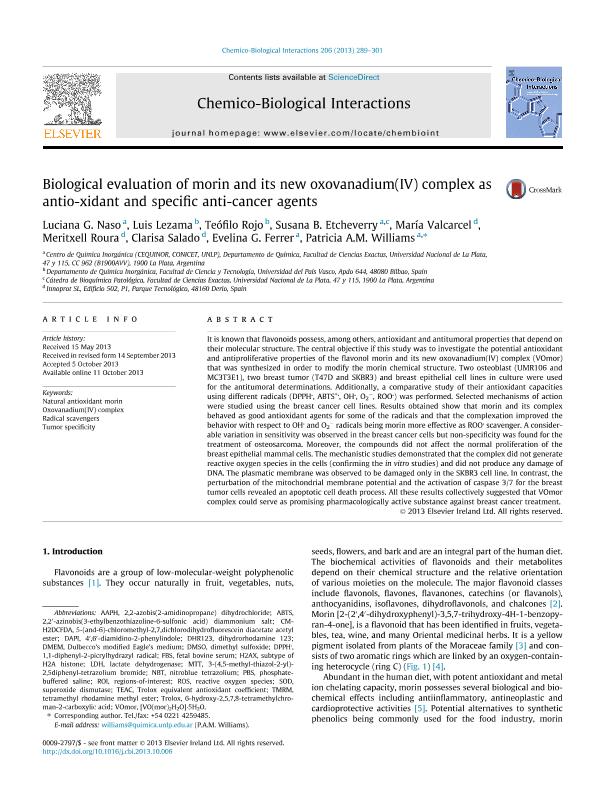Mostrar el registro sencillo del ítem
dc.contributor.author
Naso, Luciana Gissella

dc.contributor.author
Lezama, Luis Raul

dc.contributor.author
Rojo, Teófilo
dc.contributor.author
Etcheverry, Susana Beatriz

dc.contributor.author
Valcarcel, Maria
dc.contributor.author
Roura, Meritxell
dc.contributor.author
Salado, Clarisa
dc.contributor.author
Ferrer, Evelina Gloria

dc.contributor.author
Williams, Patricia Ana María

dc.date.available
2017-09-18T19:27:07Z
dc.date.issued
2013-10
dc.identifier.citation
Naso, Luciana Gissella; Lezama, Luis Raul; Rojo, Teófilo; Etcheverry, Susana Beatriz; Valcarcel, Maria; et al.; Biological evaluation of morin and its new oxovanadium(IV) complex as antio-xidant and specific anti-cancer agents; Elsevier Science; Chemico-biological Interactions; 206; 2; 10-2013; 289-301
dc.identifier.issn
0009-2797
dc.identifier.uri
http://hdl.handle.net/11336/24496
dc.description.abstract
It is known that flavonoids possess, among others, antioxidant and antitumoral properties that depend on their molecular structure. The central objective if this study was to investigate the potential antioxidant and antiproliferative properties of the flavonol morin and its new oxovanadium(IV) complex (VOmor) that was synthesized in order to modify the morin chemical structure. Two osteoblast (UMR106 and MC3T3E1), two breast tumor (T47D and SKBR3) and breast epithelial cell lines in culture were used for the antitumoral determinations. Additionally, a comparative study of their antioxidant capacities using different radicals (DPPH, ABTS+, OH, O2−, ROO) was performed. Selected mechanisms of action were studied using the breast cancer cell lines. Results obtained show that morin and its complex behaved as good antioxidant agents for some of the radicals and that the complexation improved the behavior with respect to OH and O2− radicals being morin more effective as ROO scavenger. A considerable variation in sensitivity was observed in the breast cancer cells but non-specificity was found for the treatment of osteosarcoma. Moreover, the compounds did not affect the normal proliferation of the breast epithelial mammal cells. The mechanistic studies demonstrated that the complex did not generate reactive oxygen species in the cells (confirming the in vitro studies) and did not produce any damage of DNA. The plasmatic membrane was observed to be damaged only in the SKBR3 cell line. In contrast, the perturbation of the mitochondrial membrane potential and the activation of caspase 3/7 for the breast tumor cells revealed an apoptotic cell death process. All these results collectively suggested that VOmor complex could serve as promising pharmacologically active substance against breast cancer treatment.
dc.format
application/pdf
dc.language.iso
eng
dc.publisher
Elsevier Science

dc.rights
info:eu-repo/semantics/openAccess
dc.rights.uri
https://creativecommons.org/licenses/by-nc-sa/2.5/ar/
dc.subject
Natural Antioxidant Morin
dc.subject
Oxovanadium(Iv) Complex
dc.subject
Radical Scavengers
dc.subject
Tumor Specificity
dc.subject.classification
Otras Ciencias Químicas

dc.subject.classification
Ciencias Químicas

dc.subject.classification
CIENCIAS NATURALES Y EXACTAS

dc.title
Biological evaluation of morin and its new oxovanadium(IV) complex as antio-xidant and specific anti-cancer agents
dc.type
info:eu-repo/semantics/article
dc.type
info:ar-repo/semantics/artículo
dc.type
info:eu-repo/semantics/publishedVersion
dc.date.updated
2017-09-14T13:55:00Z
dc.journal.volume
206
dc.journal.number
2
dc.journal.pagination
289-301
dc.journal.pais
Países Bajos

dc.journal.ciudad
Amsterdam
dc.description.fil
Fil: Naso, Luciana Gissella. Consejo Nacional de Investigaciones Científicas y Técnicas. Centro Científico Tecnológico Conicet - La Plata. Centro de Química Inorgánica "Dr. Pedro J. Aymonino". Universidad Nacional de La Plata. Facultad de Ciencias Exactas. Centro de Química Inorgánica "Dr. Pedro J. Aymonino"; Argentina
dc.description.fil
Fil: Lezama, Luis Raul. Universidad del País Vasco; España
dc.description.fil
Fil: Rojo, Teófilo. Universidad del País Vasco; España
dc.description.fil
Fil: Etcheverry, Susana Beatriz. Consejo Nacional de Investigaciones Científicas y Técnicas. Centro Científico Tecnológico Conicet - La Plata. Centro de Química Inorgánica "Dr. Pedro J. Aymonino". Universidad Nacional de La Plata. Facultad de Ciencias Exactas. Centro de Química Inorgánica "Dr. Pedro J. Aymonino"; Argentina. Universidad Nacional de la Plata. Facultad de Cs.exactas. Departamento de Cs.biológicas. Cátedra Bioquímica Patologica; Argentina
dc.description.fil
Fil: Valcarcel, Maria. Innoprot SL; España
dc.description.fil
Fil: Roura, Meritxell. Innoprot SL; España
dc.description.fil
Fil: Salado, Clarisa. Innoprot SL; España
dc.description.fil
Fil: Ferrer, Evelina Gloria. Consejo Nacional de Investigaciones Científicas y Técnicas. Centro Científico Tecnológico Conicet - La Plata. Centro de Química Inorgánica "Dr. Pedro J. Aymonino". Universidad Nacional de La Plata. Facultad de Ciencias Exactas. Centro de Química Inorgánica "Dr. Pedro J. Aymonino"; Argentina
dc.description.fil
Fil: Williams, Patricia Ana María. Consejo Nacional de Investigaciones Científicas y Técnicas. Centro Científico Tecnológico Conicet - La Plata. Centro de Química Inorgánica "Dr. Pedro J. Aymonino". Universidad Nacional de La Plata. Facultad de Ciencias Exactas. Centro de Química Inorgánica "Dr. Pedro J. Aymonino"; Argentina
dc.journal.title
Chemico-biological Interactions

dc.relation.alternativeid
info:eu-repo/semantics/altIdentifier/doi/http://dx.doi.org/10.1016/j.cbi.2013.10.006
dc.relation.alternativeid
info:eu-repo/semantics/altIdentifier/url/http://www.sciencedirect.com/science/article/pii/S0009279713002603
Archivos asociados
